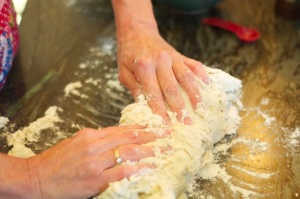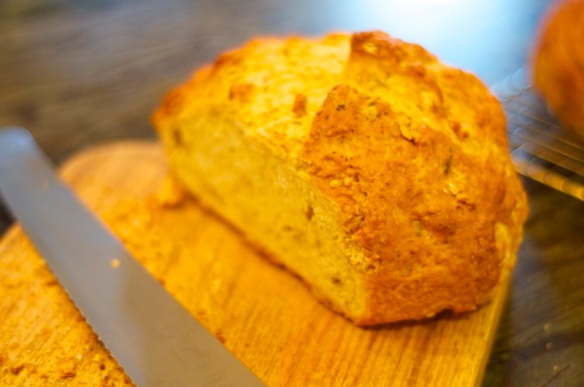 Recently Curt and I became the proud owners of a new Airstream Trailer, which has been a dream for quite some time. We set out on our maiden voyage, eager to explore the rockies during the peak fall color season. During the welcome to Airstream tour at the dealership, our guide reluctantly showed us how the oven operated, but casually mentioned “no one uses them anyway.” I took this as a challenge (OK, I admit that I can be competitive at times!) and en route, thumbing through my Molly Stevens braising cookbook, decided to tackle her Bisteces Rancheros (a fancy way of saying Shoulder Steaks Braised with Tomatoes, Potatoes & Poblano Peppers).
Recently Curt and I became the proud owners of a new Airstream Trailer, which has been a dream for quite some time. We set out on our maiden voyage, eager to explore the rockies during the peak fall color season. During the welcome to Airstream tour at the dealership, our guide reluctantly showed us how the oven operated, but casually mentioned “no one uses them anyway.” I took this as a challenge (OK, I admit that I can be competitive at times!) and en route, thumbing through my Molly Stevens braising cookbook, decided to tackle her Bisteces Rancheros (a fancy way of saying Shoulder Steaks Braised with Tomatoes, Potatoes & Poblano Peppers).
This dish is a meal unto itself and needs no accompaniment, but Molly suggests perhaps serving with a Boston lettuce salad with scallions and sliced radishes.
Serves 4-6, braising time about 1 1/2 hours
2 medium poblano peppers (about 8 ounces total)
2 pounds thin-cut (1/2″) boneless chuck or shoulder steaks, cut into 8 or 10 individual steaks
Coarse salt and freshly ground black pepper
4 tablespoons extra-virgin olive oil
1 very large or 2 medium white onions (about 12 ounces total), thinly sliced
2 large garlic cloves
1 tablespoon cumin seeds, toasted and ground
1 tablespoon coriander seeds, toasted and ground
One 28-ounce can whole peeled tomatoes with their juice
1 pound small red or white potatoes, scrubbed
2 tablespoons red wine vinegar
- Preheat oven to 325 degrees.
- Roasting the peppers: set the poblano peppers directly on a flame to high. Roast, turning with tongs as each side chars, until charred, about 8 minutes total. (If you don’t have a gas burner place under the broiler, turning with tongs until completely blistered. Transfer the peppers to a medium bowl, cover with plastic wrap, let cool until
enough to handle.
- Peeling the peppers: When the peppers are cool, slip off the skins. Avoid the temptation to rinse under the faucet or you will wash away much of their flavor (I use a paper towel to remove.) Slice the peeled peppers open, cut away the stems, remove the seeds. Cut into strips and set aside.
- Browning the steaks: Season the steaks with salt and pepper. Heat the oil in a large skillet over medium heat. Add half the steaks and cook, turning once with tongs, until they develop a ruddy brown exterior, about 3 minutes per side. Transfer to a large cazuela or other shallow bowl (I used my dutch oven) and brown the second batch. Add another tablespoon of oil and heat until it shimmers before adding the steaks.

- The aromatics and braising liquid: When all the steaks are browned, pour the oil out. If the skillet is blackened, clean it before continuing. Add the remaining 1 tablespoon oil and heat over medium-high heat. When the oil is hot, add the onions, season with salt and pepper, stir, and saute until limp and beginning to brown in spots, about 6 minutes. Add the garlic, cumin, and coriander and cook for another minute. Pour the juice from the tomato can into the skillet. Break up the tomatoes and drop into the skillet. Season with salt and pepper, stir, and simmer the juices to thicken them a bit, about 4 minutes. Taste for salt and pepper then remove from the heat.
 The braise: Slice the potatoes into 1/8″ thick rounds and layer them over the steaks. Stir the vinegar into the tomato sauce and spoon it over the potatoes. Top with the strips of peppers. Cover tightly with heavy-duty foil (or cover with the lid) and slide into the oven. Braise until the steaks and potatoes are fork-tender but not falling apart, about 1 hour.
The braise: Slice the potatoes into 1/8″ thick rounds and layer them over the steaks. Stir the vinegar into the tomato sauce and spoon it over the potatoes. Top with the strips of peppers. Cover tightly with heavy-duty foil (or cover with the lid) and slide into the oven. Braise until the steaks and potatoes are fork-tender but not falling apart, about 1 hour.
- The finish: Remove the foil, increase the oven temperature to 375 degrees, and braise until the tomato sauce is brown and crusty around the edges. another 20-25 minutes.
So because we were in such high altitude, the braise took over 2 hours! .. which is why I don’t have a photo of the dish plated .. we were so hungry we just dug in.
I’d highly recommend a visit to Ouray in the fall – it’s absolutely gorgeous! My mom and dad joined us for a few days and there was plenty of room for us to share meals together in the Airstream.
A must-do if you ever make your way up there? Stop in at Khristopher’s Culinaire right on Main Street. The owner knows everything there is to know about brewing coffee, he’s got a huge collection of spices from around the world which are very hard to find, and is just a lovely person to visit with.























